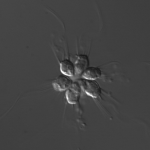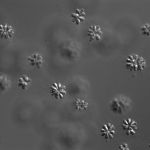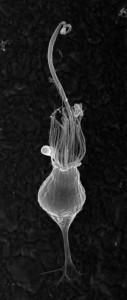Choanoflagellates and Animal Multicellularity
- The New York Times wrote about us!
What are Choanoflagellates?
Choanoflagellates are aquatic filter-feeders that are found all over the world in both marine and fresh water. They form an important link in the carbon cycle, consuming bacteria and algae and consumed in turn by larger zooplankton. They are also the closest known sister group to animals and there has recently been a surge of interest in them because of their promise to help us understand how animals first evolved.
Choanoflagellates and multicellularity
My interest in Choanoflagellates stems from an interest in the problem of co-ordination and co-operation between cells. For a while I’ve been looking for a model system to experimentally probe cell co-operation—especially in animal tissues. Going down the ladder of complexity, choanoflatellates have the simplest body-plan possible (perhaps it’s even too much of a stretch to call it a body), with cells arranged in simple clumps, often oriented in a radially around a central core. The species I’ve been working on, Salpingoeca rosetta (or S.rosetta for short), has single-celled forms and multicelled forms:
Choanoflagellates and the origin of animals
Choanoflagellates are not the ancestors of animals, but just their closest living relatives—those things that Choanoflagellates have in common with animals might have been in our last common ancestor. It’s hard to tell for certain, but the similarity in form between choanoflagellates and choanocytes (the feeding cells in sponges) is so striking that it’s tempting to imagine a choanoflagellate-like ancestor evolving into a sponge-like ancestor, by some form of cell adhesion.
The big question is why this (or some other scenario for the evolution of animal multicellularity) would have happened at all. Why become multicellular? We can’t go back in time to see directly, but we can try to answer the question of why a modern-day Choanoflagellate might switch between single-celled and multicelled forms today. This is one of the things I’m working on in Nicole King’s lab at UC Berkeley.
Because the work isn’t published yet, I can’t go into too much more detail at the moment about our findings, but we’ve made good progress recently and have some exciting leads.
If you’re interested in choanoflagellates, check out the ChoanoWiki for bunch more info and pictures: http://www.choano.org
References
Cell differentiation and morphogenesis in the colony-forming choanoflagellate Salpingoeca rosetta. Dayel MJ, Alegado R, Fairclough S, Levin T, Nichols SA, McDonald KL, King N. Developmental Biology, 2011
Genomic, phylogenetic, and cell biological insights into metazoan origins. Nichols SA, Dayel MJ, King N. (2009) In Animal evolution: genes, genomes, fossils and trees. MJ Telford, DTJ Littlewood (editors) Oxford University Press.
Multicellular development in a choanoflagellate. Fairclough SR, Dayel MJ, King N. Current Biology, Volume 20, Issue 20, R875-R876, 26 October 2010 
In a Single-Cell Predator, Clues to the Animal Kingdom’s Birth. Carroll SB. New York Times December 13, 2010
![]()
Page content under the creative commons share-alike license (include link back here).




